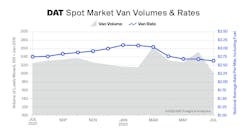Truckload freight volumes tumbled in July from their highs in June—and the spot market continues its summer slump, DAT Freight & Analytics reported this week.
“Demand for van and reefer services softened predictably in July, and freight volumes generally settled to levels seen in July 2020 and 2019. After several years of volatility, truckload volumes for van and reefer freight followed a more typical summertime pattern,” Ken Adamo, chief of analytics at DAT, which operates the DAT One truckload freight network and DAT iQ data analytics service, said in a release this week.
See also: Survey shows rebalancing of owner-operator market
In July, DAT’s Truckload Volume Index (TVI) for dry van freight was 201, down 20% compared to June. The TVI for reefer freight was 133, down 12.5%, and the flatbed TVI was 217, a 15.9% decrease month-over-month.
“While the number of flatbed loads moved was strong relative to previous years, the volume decline from May through July was steeper than expected,” Adamo added.
Spot, contract rates both decline
After gaining $1.15 since July 2020, the national average rate to move van freight under contract crested and fell to $3.21 per mile in July, down 8 cents compared to June, the DAT release said. The contract rate for reefers fell 6 cents to $3.50 a mile and the flatbed rate dropped 8 cents to $3.83 a mile.
The national average rate for spot van freight in July was $2.63 per mile, down 5 cents compared to June. The spot reefer rate was $2.99 per mile, down 6 cents and below $3 for the first time since April 2021. The flatbed rate averaged $3.29 per mile, a 17-cent decrease month-over-month. Spot rates are negotiated by the carrier and freight broker as one-time transactions.
Meanwhile, spot loads posted to the DAT One load board network fell 26% in July compared to June and dropped 34% year-over-year. The number of trucks on the network fell 9.3% month-over-month but was 8.1% higher compared to July 2021, according to the DAT release.
The national average van load-to-truck ratio fell from 3.9 in June to 3.8, meaning there were 3.8 available loads for every van on the DAT network. The reefer load-to-truck ratio was 7.2, up from 7.0. The flatbed ratio declined sharply for the second straight month, falling from 63.3 in May to 37.6 in June to 21.8 in July, according to DAT Freight & Analytics.
See also: Diesel surges well above $5, the first rise in more than two months
Also, according to the firm, diesel price relief in July had an impact on fuel surcharges. The U.S. average retail price of diesel was $5.48 per gallon in July, 27 cents lower than June, according to the U.S. Energy Information Administration. Surcharges averaged 71 cents a mile for van freight, 77 cents a mile for reefers, and 85 cents a mile for flatbed freight—all three were down nearly 5 cents from record highs in June, when the nationwide average for diesel fuel reached records, according to DAT.
The DAT Truckload Volume Index is produced by DAT iQ and reflects the change in the number of van, refrigerated, and flatbed loads moved under contract and the spot market with a pickup date during that month. Index numbers are normalized each month to accommodate any new data sources without distortion. Baseline of 100 equals the number of loads moved in January 2015, according to DAT.
Rates are derived from RateView, DAT’s database of $137 billion in annualized freight transactions for loads moved, not the “asking price” posted to the load board, on over-the-road lanes with lengths of haul of 250 miles or more. Spot rates represent the payments made to carriers by freight brokers, third-party logistics providers and other transportation buyers. Contract rates are paid by the shipper to the carrier.
FTR, Truckstop.com weigh in
Data from another load board, Truckstop.com, and FTR Transportation Intelligence for the week ended Aug. 26 shows greater stability than had been the case in recent weeks, Juli Burda, Truckstop’s director of corporate communications, said in an email exchange with FleetOwner.
The total broker-posted rate in the system declined modestly during the week, although the dry van segment posted a slight increase, according to the email from Burda. Spot rates in the refrigerated and flatbed segments fell, but the decreases were smaller than in the previous week.
See also: ATRI: Trucking endures 'costliest year ever'
The spot market and declines there have been the focus for much of the summer. For week 34 of 2022 in the spot market, two of the four key market indicators increased, according to a Truckstop release.
The overall Market Demand Index (MDI) rose by 1.3 points to 55.5 as load availability increased 1% but truck availability declined 1.4%. Compared to last year, the MDI is down 100.3 points, or 64.4%. Last week, market rates fell 1.2% to $2.60. Compared to last year, rates are down 11.8%.
About the Author
Scott Achelpohl
Managing Editor
Scott Achelpohl is a former FleetOwner managing editor who wrote for the publication from 2021 to 2023. Since 2023, he has served as managing editor of Endeavor Business Media's Smart Industry, a FleetOwner affiliate.


